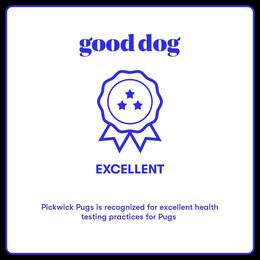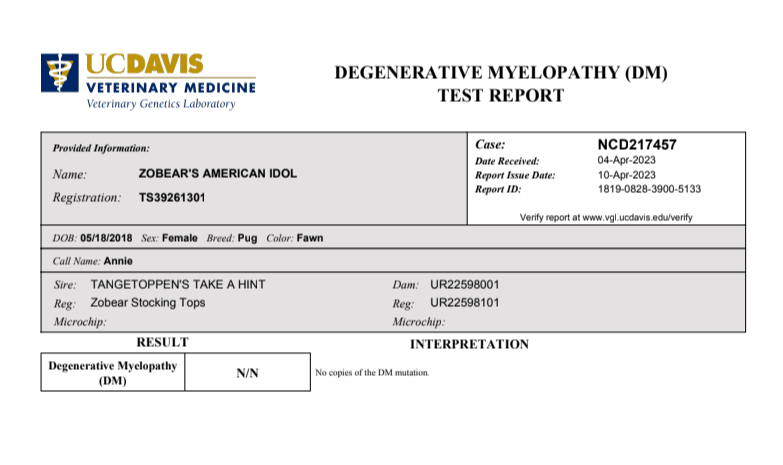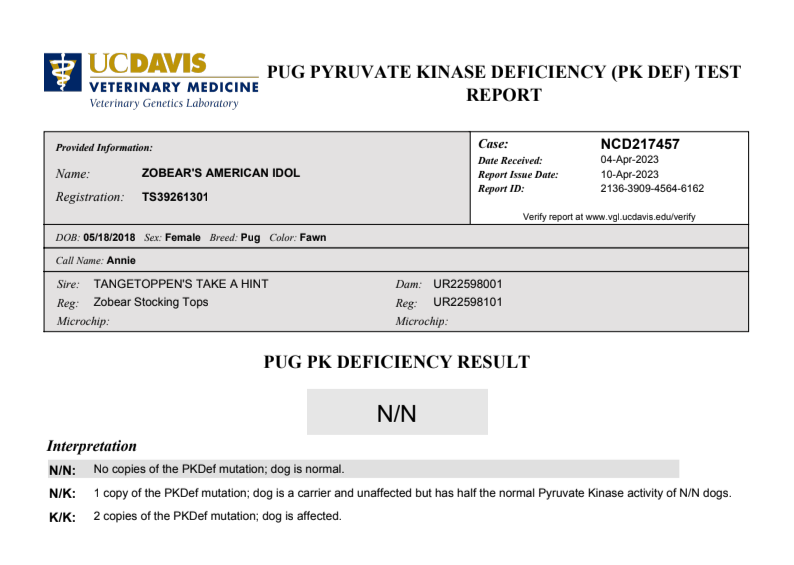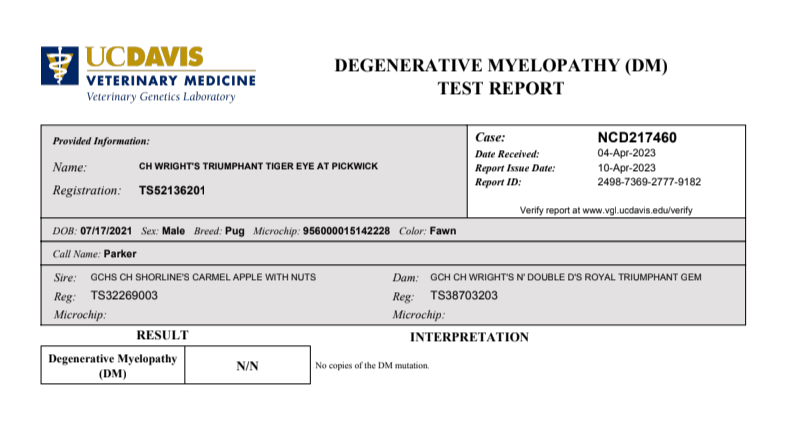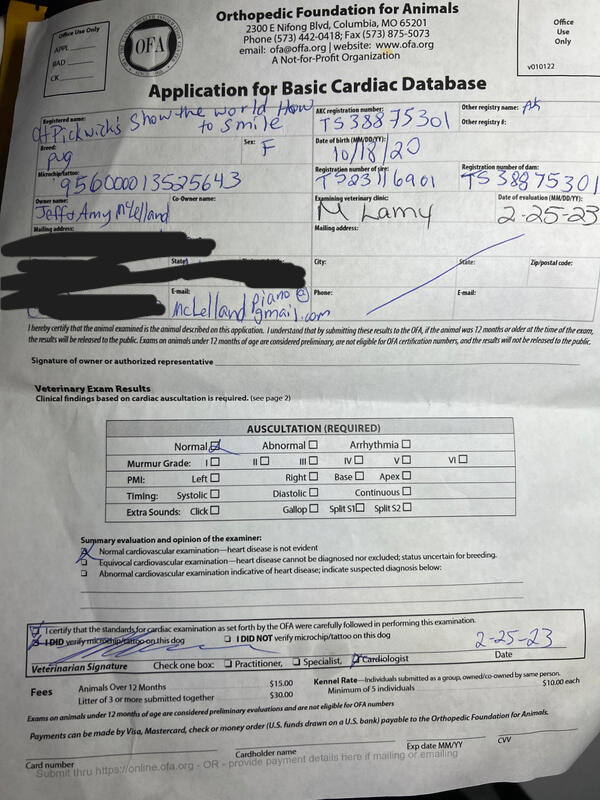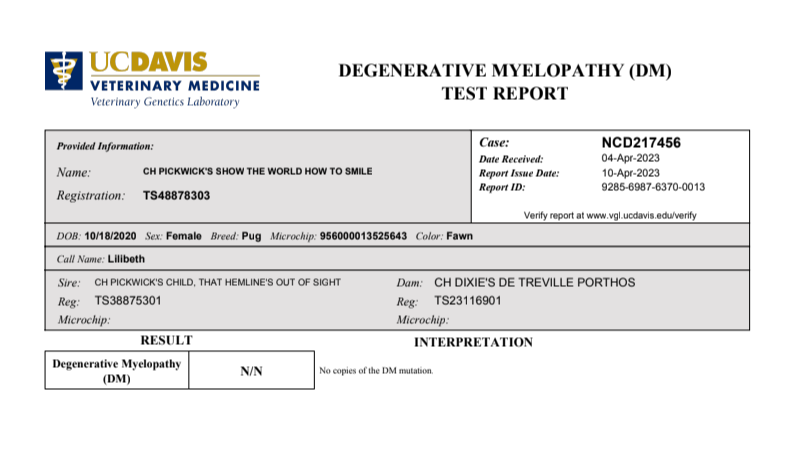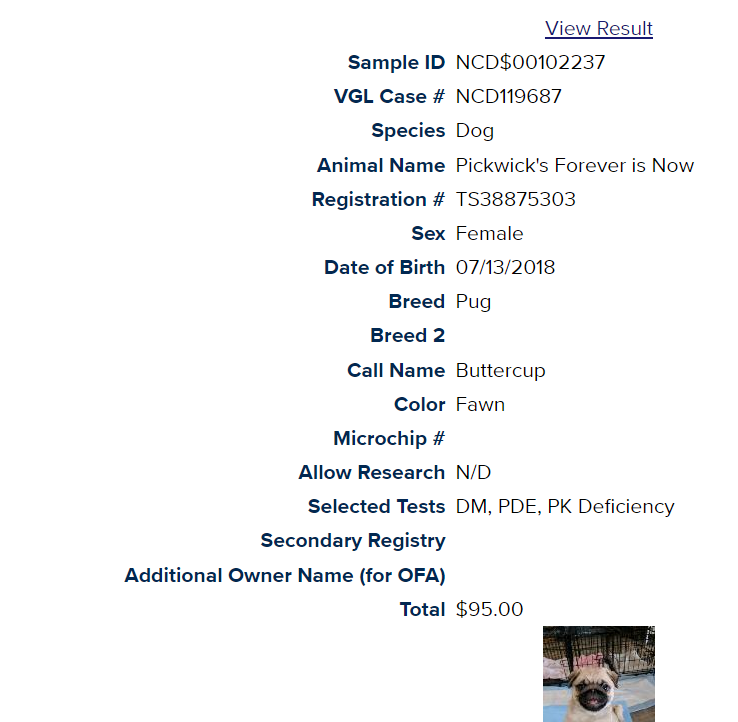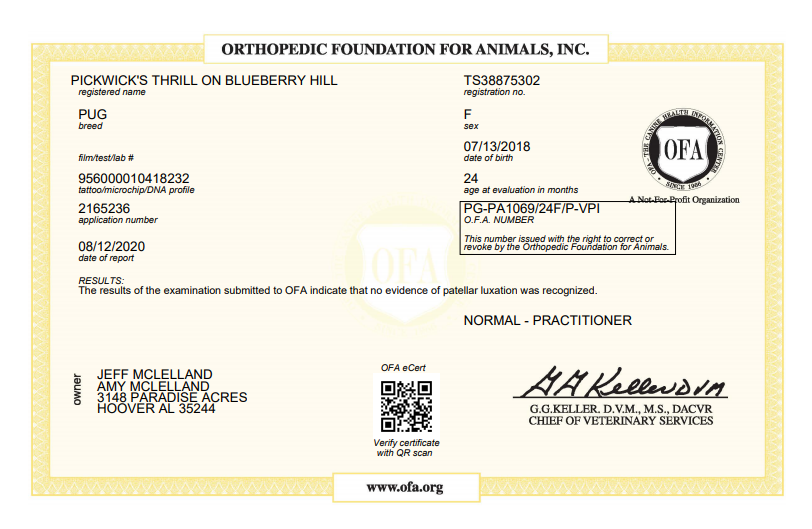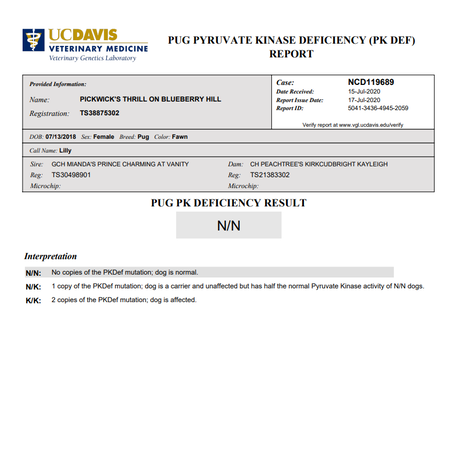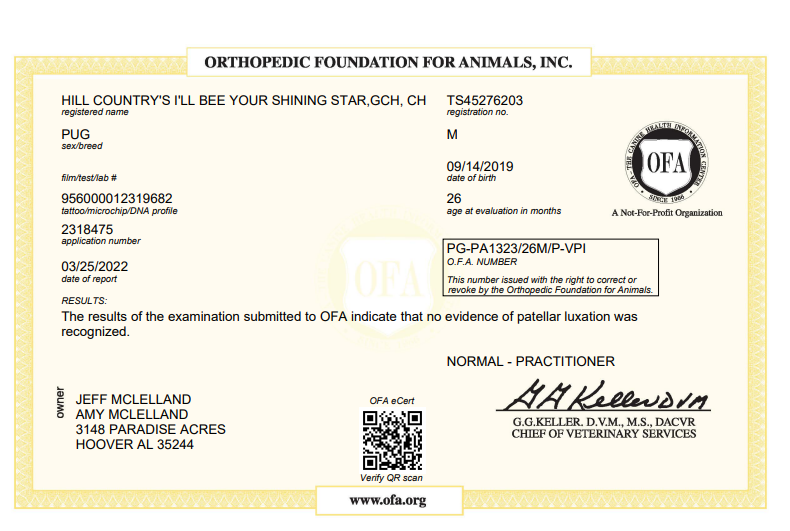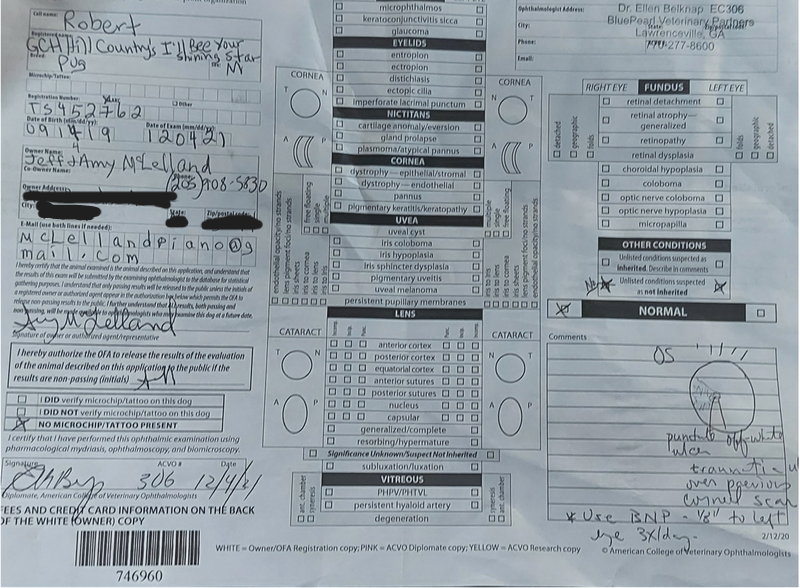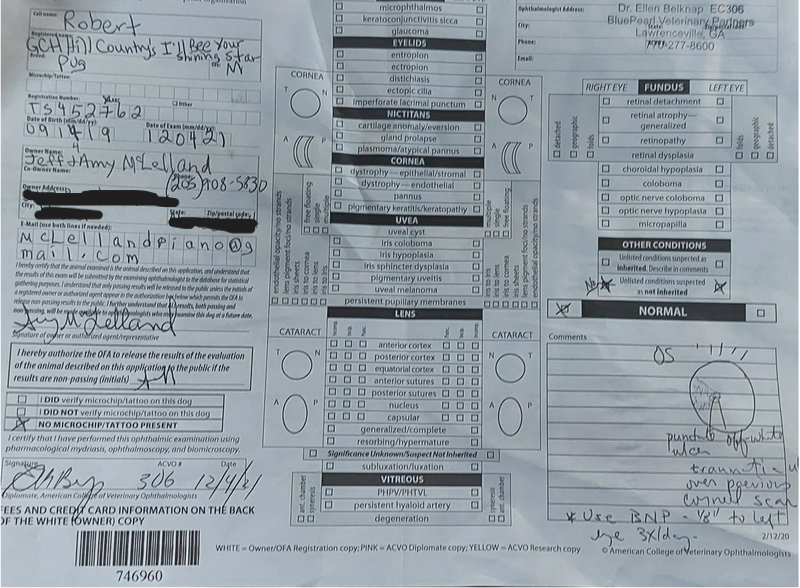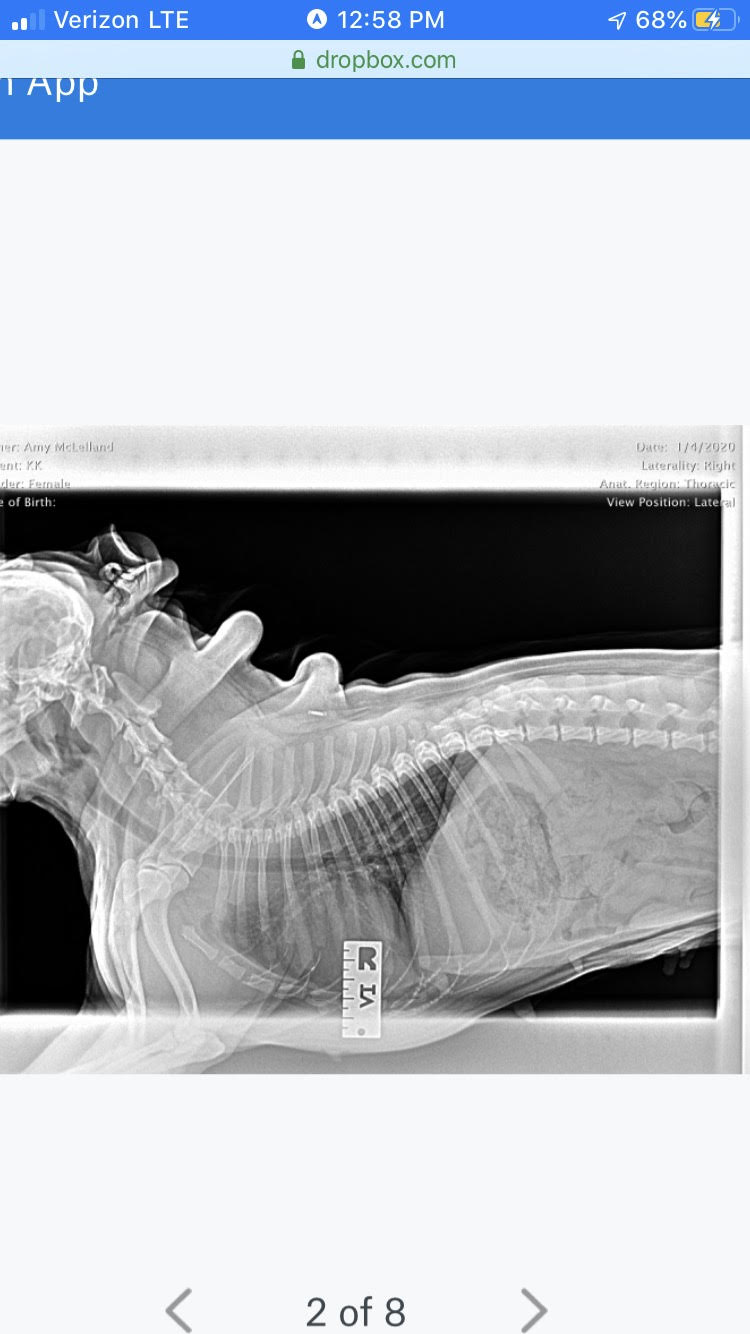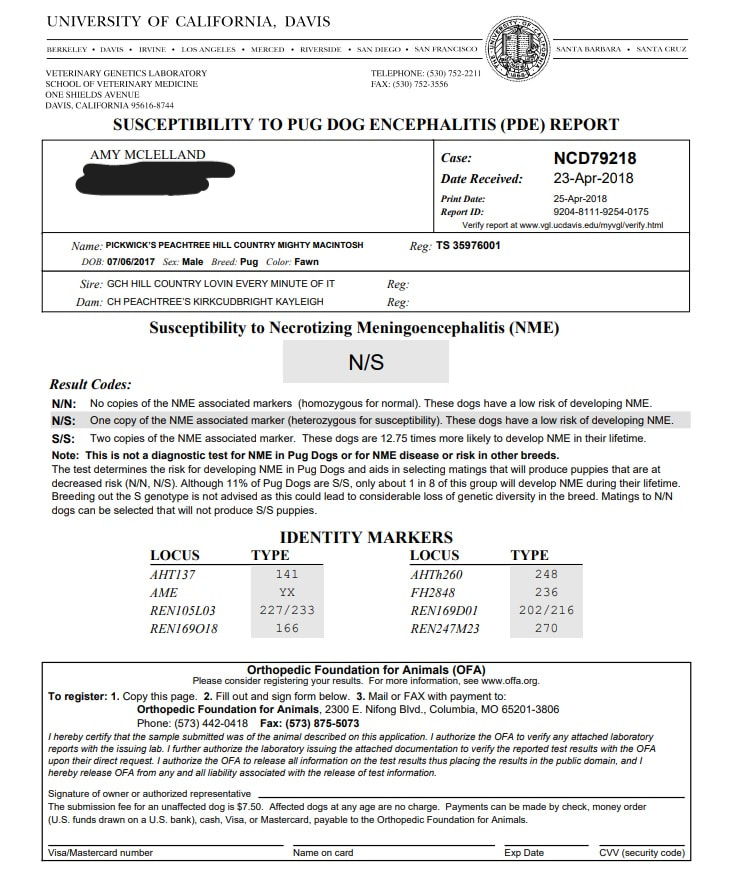We strive to produce pugs who are beautiful inside and out.
We believe that overall health, sound temperament, and sociability are just as important as outward looks when meeting breed standard.
We believe that overall health, sound temperament, and sociability are just as important as outward looks when meeting breed standard.
Health Tested:
Once you have been owned by a pug, it becomes quite obvious why they are one of the oldest breeds of dogs and have flourished since before 400 B.C. Our goal at Pickwick Pugs is to keep this breed flourishing. To that end, we fully support and promote PDE susceptibility testing and other important health scheme testing of our pugs to be bred.
Health-Testing
We believe strongly in the importance of health-testing and utilize every tool possible when choosing our breeding stock. If any of our breeding stock, including those who have completed AKC Championships, do not satisfactorily meet our high standards and pass important health tests, they are spayed or neutered and not part of our breeding program. If a pug does not sufficiently pass an important test, they are out of the breeding program and spayed or neutered. We include the tests recommended by the Pug Dog Club of America (the AKC parent club for pugs):
Health Guarantee
Once you have been owned by a pug, it becomes quite obvious why they are one of the oldest breeds of dogs and have flourished since before 400 B.C. Our goal at Pickwick Pugs is to keep this breed flourishing. To that end, we fully support and promote PDE susceptibility testing and other important health scheme testing of our pugs to be bred.
Health-Testing
We believe strongly in the importance of health-testing and utilize every tool possible when choosing our breeding stock. If any of our breeding stock, including those who have completed AKC Championships, do not satisfactorily meet our high standards and pass important health tests, they are spayed or neutered and not part of our breeding program. If a pug does not sufficiently pass an important test, they are out of the breeding program and spayed or neutered. We include the tests recommended by the Pug Dog Club of America (the AKC parent club for pugs):
- Hip Dysplasia - OFA Evaluation
- Patellar Luxation - OFA Evaluation
- OFA or CERF Eye Examination - by and opthalmologist
- Pug Dog Encephalitis (PDE) - DNA test for Necrotizing Meningoencephalitis
- Pyruvate Kinase Deficiency (PKD) (Optional) - DNA based PKD test results from an approved lab
- Pickwick Pugs also includes additional health screening which is not required such as
- Cardiac Evaluations with a board-certified veterinary cardiologist
- Spinal x-rays to rule out Hemivertebrae
- Degenerative Myelophathy (DM) (DNA swab testing)
- BOAS testing "graded" by veterinarian
- All of these health tests must be completed after a pug is 1 years of age (and 2 years of age for the hip Xray). No matter how beautiful a pug may be, or how many championships he or she may have earned, we will not breed a pug who did not satisfactorily pass all of these health tests. We will not breed a pug with a hip score of moderate or worse. We will not breed a pug who is S/S. We will not breed a pug who has any sign of luxating patellar. We will not breed a pug with hemivertebrae. We will not breed a pug who is not a good breather. We will not breed a pug who does not satisfactorily "pass" a temperament test. We will never breed a pug who has not been deemed by our board-certified veterinarians to be in good health and worthy of being bred.
- EDUCATION: Pickwick pugs promises to pursue AKC provided or AKC approved continuing breeder education so that we stay educated on the best breeding practices, including advances in canine health.
- ACCOUNTABILITY: Pickwick Pugs agrees to comply with the AKC Care and Conditions Policy, including inspections by the AKC, and promises to share with AKC health testing and continuing education documentation.
- RESPONSIBILITY: Pickwick Pugs accepts responsibility for the health and well-being of the puppies we produce and for complying with all laws regarding the ownership and maintenance of dogs.
- TRADITION: Pickwick Pugs upholds the AKC’s tradition of breeding purebred dogs that are happy and healthy.
Health Guarantee
It is important to note that buying from a reputable, conscientious breeder does not guarantee perfect health for life. Therefore, it is important to research all of the challenges you may face when owning a pug. In general, the pug breed often deals with hip dysplasia, elongated soft palates, PDE, PK, other eye problems, and other issues. A good starting source is the Pug Dog Club of America. Prospective puppy buyers and pug owners might also speak with a vet who has dealt with pugs to learn what you might possibly expect throughout a pug’s lifetime. All breeds, including poodles, golden retrievers, labradors, and even All-American mixes and Doodles, have their unique health challenges and it is important to research these and plan accordingly.
Here are some of our health screening results (and you can also find test results on individual pug's webpages):
Some tips in understanding scores:
EYES (CERF): Pugs are prone to eye problems so we screen annually with a Veterinary Opthalmologist who looks for problems such as Dry Eye (Keratoconjuncivitis Sicca or KCS, Pigmentary Keratopathy or PK, Dystichia which is involves eyelashes that grow towards the eye, Entropion which involves eye lids that roll inwards towards the eye and Proptosis which is a buldging of the eyes.
Luxating Patellas - Kneecap that moves too much or is out of place
Pug Dog Encephalitis (PDE) - Inflammatory brain disease
Hip Dysplasia - Issues with the Hip Joint
HIPS: Many breeds of dogs are prone to hip dysplasia but, whereas larger breeds suffer to the point of needing major surgery, pugs and bulldogs are typically able to live normal lives even with mild dysplasia. They are built differently yet, still graded on the same scale as larger breeds, therefore it is quite rare to find a pug with a score of "good". Usually pugs are scored "mild" or "fair" or "borderline" which is considered normal for a pug. While many breeders will include a pug with a very low score in their breeding program, we prefer to have a score of "moderate" or below as our cut off. The Hip X-ray is not available until the pug is 2 years of age or older which can be frustrating when it becomes necessary to spay or neuter a grand champion pug who is amazing in all ways yet, the hips were severely dysplastic. Interestingly, it is not possible to observe this with the naked eye (until, sometimes, the pug is advanced in age) and only an x-ray will show if a pug suffers from severe hip dysplasia.
LUXATING PATELLA: "Normal" means no evidence of luxating patellar.
PDE (Pug Dog Encephalitis): PDE is an inflammatory fatal brain disease. N/N or N/S are acceptable scores. S/S is risky and should not be bred. However, it is important that breeders do not breed out the S gene. (Breeders have mentioned that they have had pugs with S/S die from PDE but also with N/N, but never N/S.) PDE testing should never be skipped by any pug breeder.
PKDef : N/N is a good score. Pyruvate kinase (PK) deficiency is a rare, inherited enzyme defect that causes red blood cells (RBCs) to break down faster than they are made, which leads to lifelong hemolytic anemia.
In addition to the recommended tests above, we at Pickwick Pugs have also included:
Cardiac evaluations
Spinal X-ray to make sure there is no congenital vertebral anomalies, wedge vertebrae (hemivertebrae). An information resource for prospective pet owners
Tracheal Hypoplasia Evaluation
Temperament Evaluations
Here are some of our test results (see pugs' individual webpages as well) . . . . .
EYES (CERF): Pugs are prone to eye problems so we screen annually with a Veterinary Opthalmologist who looks for problems such as Dry Eye (Keratoconjuncivitis Sicca or KCS, Pigmentary Keratopathy or PK, Dystichia which is involves eyelashes that grow towards the eye, Entropion which involves eye lids that roll inwards towards the eye and Proptosis which is a buldging of the eyes.
Luxating Patellas - Kneecap that moves too much or is out of place
Pug Dog Encephalitis (PDE) - Inflammatory brain disease
Hip Dysplasia - Issues with the Hip Joint
HIPS: Many breeds of dogs are prone to hip dysplasia but, whereas larger breeds suffer to the point of needing major surgery, pugs and bulldogs are typically able to live normal lives even with mild dysplasia. They are built differently yet, still graded on the same scale as larger breeds, therefore it is quite rare to find a pug with a score of "good". Usually pugs are scored "mild" or "fair" or "borderline" which is considered normal for a pug. While many breeders will include a pug with a very low score in their breeding program, we prefer to have a score of "moderate" or below as our cut off. The Hip X-ray is not available until the pug is 2 years of age or older which can be frustrating when it becomes necessary to spay or neuter a grand champion pug who is amazing in all ways yet, the hips were severely dysplastic. Interestingly, it is not possible to observe this with the naked eye (until, sometimes, the pug is advanced in age) and only an x-ray will show if a pug suffers from severe hip dysplasia.
LUXATING PATELLA: "Normal" means no evidence of luxating patellar.
PDE (Pug Dog Encephalitis): PDE is an inflammatory fatal brain disease. N/N or N/S are acceptable scores. S/S is risky and should not be bred. However, it is important that breeders do not breed out the S gene. (Breeders have mentioned that they have had pugs with S/S die from PDE but also with N/N, but never N/S.) PDE testing should never be skipped by any pug breeder.
- Dogs with N/N haplotype have no copies of the NME-associated risk variants and are at low risk of developing necrotizing meningoencephalitis. They cannot transmit these NME risk variants to their offspring.
- Dogs with N/S haplotype have one copy of the NME-associated risk variants and are at low risk of developing necrotizing meningoencephalitis. They may transmit these NME risk variants to 50% of their offspring.
- Dogs with S/S haplotype have two copies of the NME-associated risk variants and are 12.75 times more likely to develop necrotizing meningoencephalitis in their lifetimes. They will transmit these NME risk variants to all of their offspring.
PKDef : N/N is a good score. Pyruvate kinase (PK) deficiency is a rare, inherited enzyme defect that causes red blood cells (RBCs) to break down faster than they are made, which leads to lifelong hemolytic anemia.
- Dogs with N/N genotype will not have pyruvate kinase deficiency and cannot transmit this variant to their offspring.
- Dogs with N/K genotype are not expected to show signs of pyruvate kinase deficiency but have half the normal level of pyruvate kinase activity, and are carriers. They may transmit this variant to 50% of their offspring. Matings between two carriers are predicted to produce 25% pyruvate kinase deficiency-affected puppies.
- Dogs with K/K genotype will have pyruvate kinase deficiency.
In addition to the recommended tests above, we at Pickwick Pugs have also included:
Cardiac evaluations
Spinal X-ray to make sure there is no congenital vertebral anomalies, wedge vertebrae (hemivertebrae). An information resource for prospective pet owners
Tracheal Hypoplasia Evaluation
Temperament Evaluations
Here are some of our test results (see pugs' individual webpages as well) . . . . .
We have also attended workshops and seminars, like this one with ortho specialist Dr. Cindy Grant. Sebastian is one of our rescue pugs (and neutered, not part of the breeding program) however he was very active in rally obedience, and canine freestyle when he was younger.

